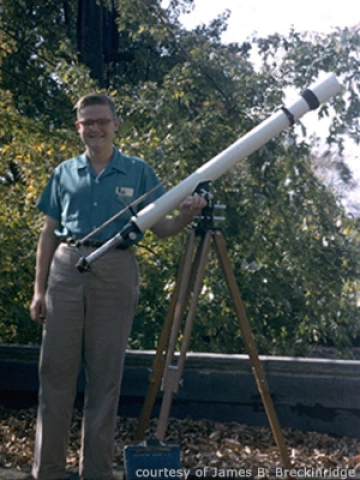Etendue: James B. Breckinridge
Welcome to Etendue, featuring interesting and accomplished individuals known for their leadership and contributions both with their careers and the College of Optical Sciences, in their own words. (For a similar view on the college’s best and brightest – our students – please check out Another Wavelength among our Students in the Spotlight.)
This week, we hear from James B. Breckinridge, Ph.D. 1976.

Where are you from?
I was born in Cleveland, Ohio, and raised in the suburbs on the second floor of an apartment building on Overlook Road in Cleveland Heights. It was within walking distance of the campus of Case Institute of Technology (now Case Western Reserve University). This is the place where Michelson and Morley did their famous Ether drift experiment using an optical interferometer.
Who or what influenced your interest in optics?
When I was 11 or 12, I had a paper route and an intense interest in astronomy. I sold my Lionel Electric train layout, added money from my paper route and purchased a telescope, so I could do observational astronomy. I was the youngest member of the American Association of Variable Star Observers at the age of 14. I tried to build a better telescope and realized I needed to know something about optics.

Describe your career.
I earned a B.Sc. in physics from Case in 1961 and took a job as an observing assistant at Lick Observatory on Mount Hamilton, California, where I worked with Kron building imaging intensifier tubes, doing six-color photoelectric photometry. After three years I wanted something different, so I took a job at Zenith Radio in Chicago building image converter tubes. After one year I wanted to go back to graduate school and discovered I really needed to move to Tucson to do that. I worked at Kitt Peak National Observatory until I had Arizona state residence then enrolled in astronomy at UA, met Aden Meinel and transferred to optics because I wanted to build instruments. I was at Kitt Peak from 1964 to 1976.
By 1976 I had an M.S. and Ph.D. in optics, a wife, and two children, and I took a job at the Jet Propulsion Laboratory to design and build optical instruments for space-based remote sensing. In 1999 I had the opportunity to go to NSF (in Washington, D.C.) to manage their astronomical telescopes and instruments program. I returned to JPL in 2003 to work as the chief technologist for the NASA Origins program. I retired in 2010. During my career I kept teaching my optics class at Caltech. When I retired I received an academic appointment to keep teaching and working with students building CubeSat astronomical telescopes.

Describe your current job.
I spend about 40 hours per month consulting for industry. As soon as I retired I wrote a textbook, Basic Optics for the Astronomical Sciences, for my Caltech class. I mentor Caltech students building a reconfigurable space telescope. We spend April in Tucson where I collaborate with Russell Chipman and Olivier Guyon.
Share your single best OSC experience.
My four semesters of classes from Roland Shack, and being able to take the courses I wanted to in physics and electrical engineering and have them count towards my optics Ph.D.
Why is staying involved with OSC important to you? How are you involved?
I discovered that I need to be near students and to exchange ideas and to continue research in the optical sciences for remote sensing scientific measurements. I collaborate with Russell Chipman (who, by the way, was a student in my Caltech optics class), and I teach three classes in optical system engineering for Olivier Guyon. [Editor's note: Breckinridge and his wife, Ann, also offer annual gifts in support of teaching laboratories and scholarships.]
Name one neat fact about you.
I was the scoutmaster for the JPL Boy Scouts of America Troop 509 for five years.
Photos from top: Breckinridge with telescope in 1955; Marjorie and Aden Meinel with Breckinridge at the Great Wall of China in 1987
